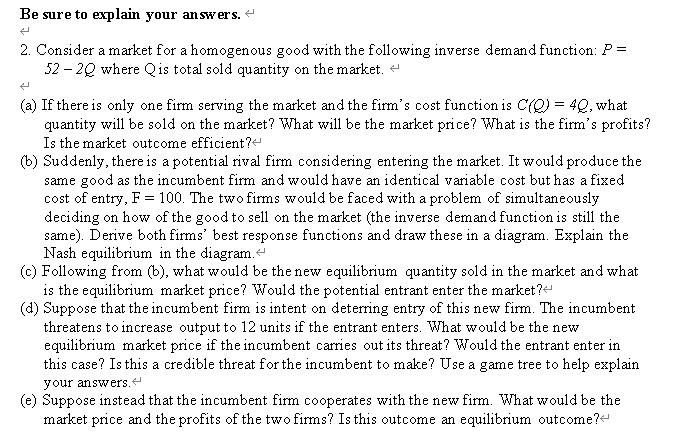2. Consider a market for a homogenous good with the following inverse demand function: P = 52 – 2Q where Qis total sold quantity on the market. (a) If there is only one firm serving the market and the firm's cost function is C(Q) = 4Q, what quantity will be sold on the market? What will be the market price? What is the firm's profits? Is the market outcome efficient? (b) Suddenly, there is a potential rival firm considering entering the market. It would produce the same good as the incumbent firm and would have an identical variable cost but has a fixed cost of entry, F = 100. The two firms would be faced with a problem of simultaneously deciding on how of the good to sell on the market (the inverse demand function is still the same). Derive both firms' best response functions and draw these in a diagram. Explain the Nash equilibrium in the diagram. (c) Following from (b), what would be the new equilibrium quantity sold in the market and what is the equilibrium market price? Would the potential entrant enter the market?
2. Consider a market for a homogenous good with the following inverse demand function: P = 52 – 2Q where Qis total sold quantity on the market. (a) If there is only one firm serving the market and the firm's cost function is C(Q) = 4Q, what quantity will be sold on the market? What will be the market price? What is the firm's profits? Is the market outcome efficient? (b) Suddenly, there is a potential rival firm considering entering the market. It would produce the same good as the incumbent firm and would have an identical variable cost but has a fixed cost of entry, F = 100. The two firms would be faced with a problem of simultaneously deciding on how of the good to sell on the market (the inverse demand function is still the same). Derive both firms' best response functions and draw these in a diagram. Explain the Nash equilibrium in the diagram. (c) Following from (b), what would be the new equilibrium quantity sold in the market and what is the equilibrium market price? Would the potential entrant enter the market?
Chapter12: The Partial Equilibrium Competitive Model
Section: Chapter Questions
Problem 12.9P
Related questions
Question

Transcribed Image Text:Be sure to explain your answers.
2. Consider a market for a homogenous good with the following inverse demand function: P =
52 – 20 where Qis total sold quantity on the market. +
(a) If there is only one firm serving the market and the firm's cost function is C(O) = 4Q, what
quantity will be sold on the market? What will be the market price? What is the firm's profits?
Is the market outcome efficient?
(b) Suddenly, there is a potential rival firm considering entering the market. It would produce the
same good as the incumbent firm and would have an identical variable cost but has a fixed
cost of entry, F = 100. The two firms would be faced with a problem of simultaneously
deciding on how of the good to sell on the market (the inverse demand function is still the
same). Derive both firms' best response functions and draw these in a diagram. Explain the
Nash equilibrium in the diagram.
(c) Following from (b), what would be the new equilibrium quantity sold in the market and what
is the equilibrium market price? Would the potential entrant enter the market?
(d) Suppose that the incumbent firm is intent on deterring entry of this new firm. The incumbent
threatens to increase output to 12 units if the entrant enters. What would be the new
equilibrium market price if the incumbent carries out its threat? Would the entrant enter in
this case? Is this a credible threat for the incumbent to make? Use a game tree to help explain
your answers.
(e) Suppose instead that the incumbent firm cooperates with the new firm. What would be the
market price and the profits of the two firms? Is this outcome an equilibrium outcome?
Expert Solution
This question has been solved!
Explore an expertly crafted, step-by-step solution for a thorough understanding of key concepts.
This is a popular solution!
Trending now
This is a popular solution!
Step by step
Solved in 2 steps with 1 images

Knowledge Booster
Learn more about
Need a deep-dive on the concept behind this application? Look no further. Learn more about this topic, economics and related others by exploring similar questions and additional content below.Recommended textbooks for you



